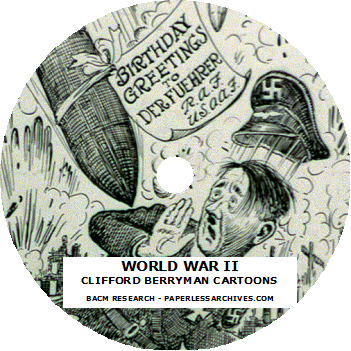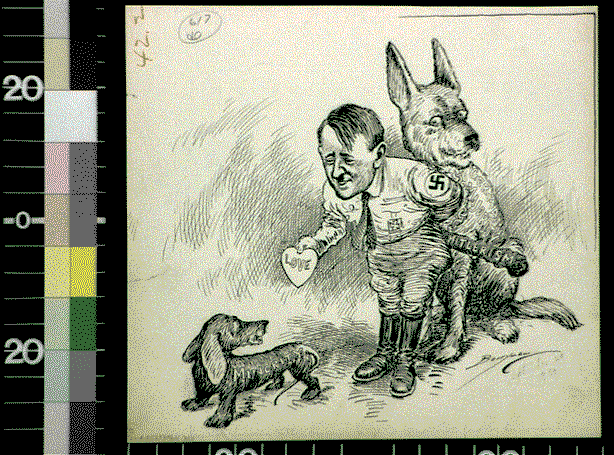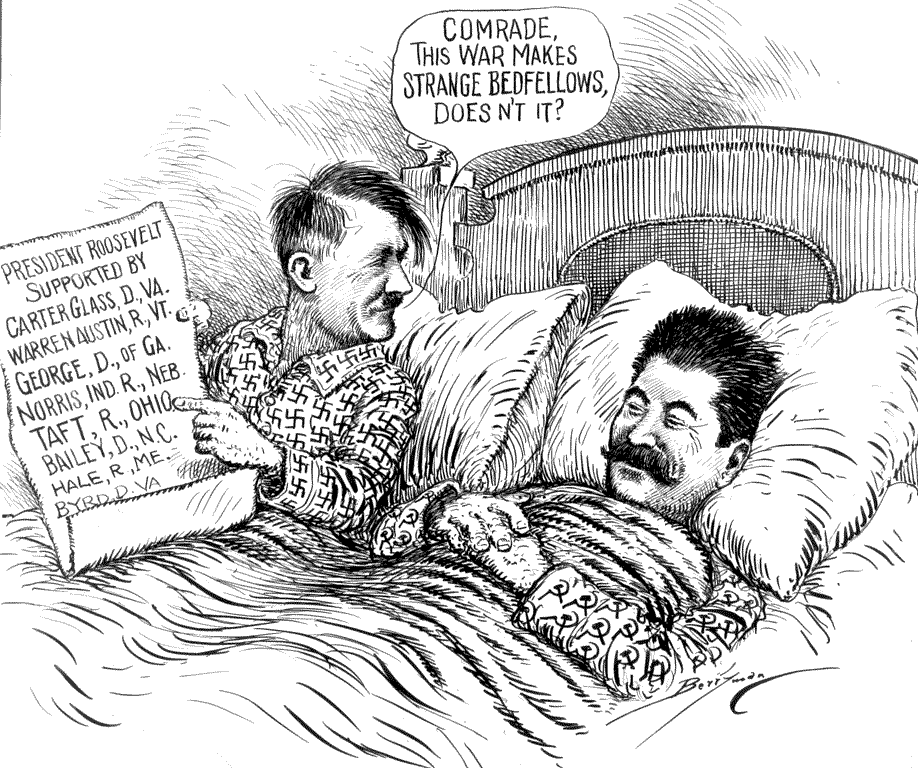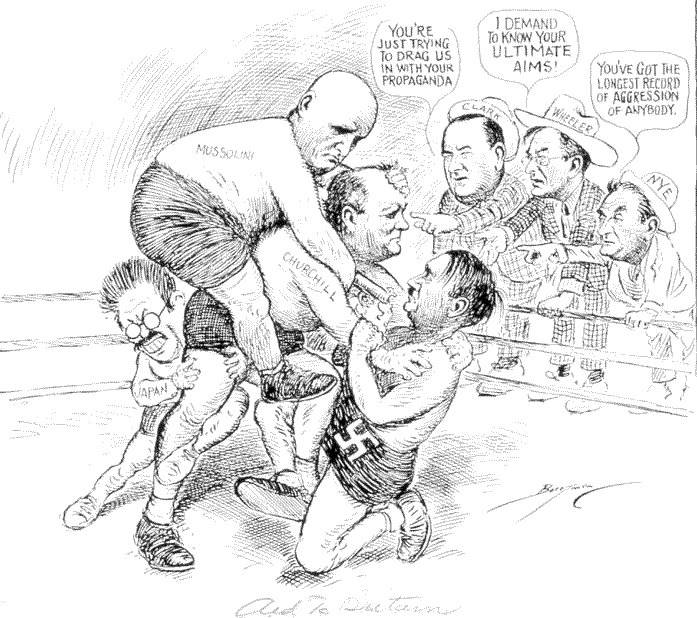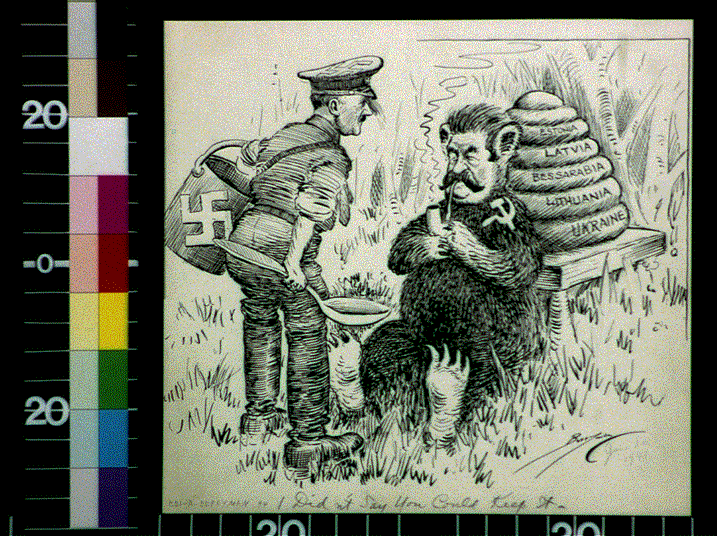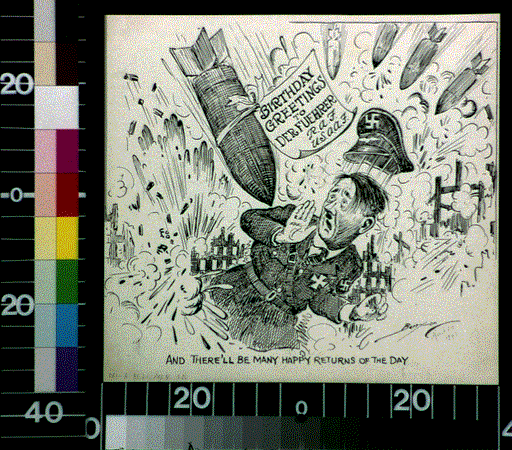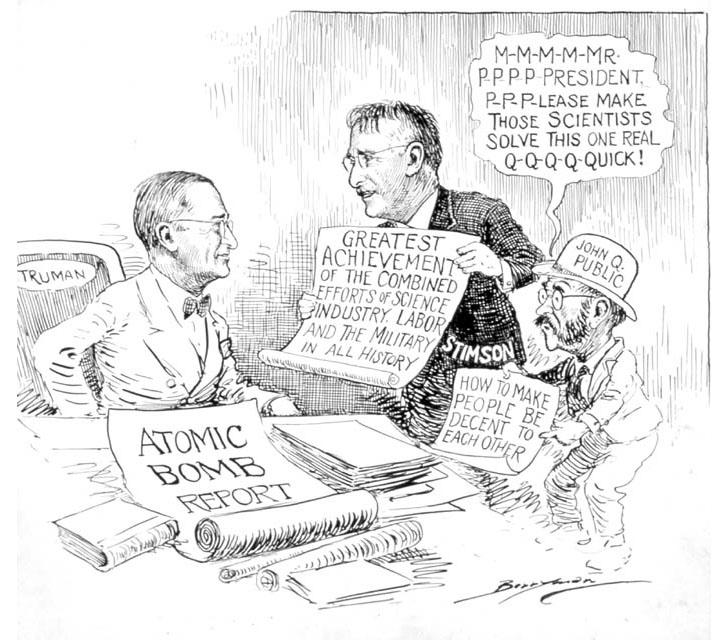|
|
|||||||||||||
|
|
|||||||||||||
|
WORLD WAR II |
|
|
||||||||||||||||||||||||||||||||||||||||
|
Clifford Berryman is remembered as one of the best political commentators of the first half of the 20th century. Berryman's drawings commented on tense and divisive issues in Washington and the world, sometimes in a lighthearted, yet thought-provoking way. The drawings date from 1933 to 1949. Each illustration is preceded by a descriptive catalog sheet, which has background information about the cartoon. The coverage includes the rise of Hitler, the march toward war in Europe, relations and conflicts between Hitler, Stalin, Mussolini, Chamberlain, Churchill, Franco, Chiang Kai-Shek, and Daladier, United States foreign relations, American domestic politics concerning aiding the Allies and entering the War, home front and war effort issues and the progress of the war. The original drawings presented in this collection are larger than how they appeared in newspapers. The process for reproducing cartoons in newspapers during Berryman's time called for the drawing to be photographed. The negative image was then projected onto an engraving plate and reduced to the size that it would occupy in the newspaper. An engraver then traced the image onto a printing plate by etching the metal with powder or acid. The plate was then used to print the image. Clifford Kennedy Berryman (1869-1949), American artist and cartoonist, famous as the originator of the Teddy Bear, during Theodore Roosevelt's presidency. In 1886, when he was 17 years old, Berryman moved from Kentucky to Washington, DC, to work at the U.S. Patent Office, where his talents as a self-taught illustrator were employed to draw patent illustrations. In 1891, he became a cartoonist's understudy for the Washington Post. By 1896, he was the chief cartoonist. In 1907, Berryman took the position of front-page cartoonist at the Washington Evening Star. Berryman drew political cartoons for the Star until his death in 1949. Berryman's most famous cartoon, "Drawing the Line in Mississippi," appeared in the November 16, 1902 edition of the Washington Post. The cartoon portrayed the image of a "teddy bear" for the first time, appearing next to President Theodore Roosevelt. By some estimates, Berryman drew over 15,000 cartoons in his lifetime and his work was recognized in 1944 with a Pulitzer Prize for editorial cartooning. In 1949, President Harry Truman complimented Berryman saying, "You are a Washington institution comparable to the Monument." A January 27, 1937 illustration, "Dictator's Club," showing Hitler, Stalin, and Italy in the "Dictator's Club", smoking and discussing how FDR can "Get In Step". The January 1, 1941 New Years Day cartoon shows Baby New Year standing in America on a map holding a football helmet marked "USA" looking over at a German military helmet marked "Europe" and saying, "Gee! Have I got to take that one too? A December 3, 1941 cartoon titled, "War Exit-Peace Exit." This prophetic cartoon published 4 days before the Pearl Harbor attack, shows Secretary of State Cordell Hull speaking to Japanese ambassador to the United States Kichisaburo Nomura and Japanese diplomat Saburo Kurusu, as they are walking through revolving doors with exits marked "war" and "peace". Hull tells them they "Have to Decide Where [they] Want To Get Out". A December 8, 1941, drawing titled, "Once again I call upon every American to do his duty." Drawn the day after the Japanese attack on Pearl Harbor, it shows Uncle Sam urging Americans to come to the defense of their country. Behind him stand the ghostly figures of soldiers from the American Revolution, the Civil War, and the First World War. The caption is a paraphrase of the famous exhortation by British Admiral Lord Nelson to his fleet before the Battle of Trafalgar. An April 17, 1942 illustration titled, "I think that's MacArthur's way of telling us he's keeping his promise to return to the Philippines." It shows Lieutenant General Jonathan Wainwright with his aide, standing on the rocky shores of Corregidor, looking through eyeglasses at explosions across the water in Manila. The aide says, "They look something like smoke signals, General." Wainwright responds, "I think that's MacArthur's way of telling us that he's keeping his promise to return to the Philippines." After the bombing of Pearl Harbor, the Japanese attacked and rapidly overran the Philippines. American forces under General Douglas MacArthur retreated, first to Bataan and then to the island fortress of Corregidor. At President Roosevelt's order, MacArthur escaped and returned to Australia, vowing, "I shall return," leaving Wainwright in command. The Americans mounted a bombing raid on Japanese installations in the Philippines on April 15, but on May 6, the forces on Corregidor were forced to surrender. The Americans did return, eventually, landing in October 1944. A February 1, 1942 cartoon titled, "Der Fuehrer says you must win the war or be enslaved by the Bolshevists." This cartoon shows German propaganda minister Joseph Goebbels admonishing a ragged battered old man labeled "Germany," who carries a tattered paper reading, "Promise of Victory." The old man is surrounded by threatening soldiers, one labeled "Gestapo." Goebbels says, "Der Fuehrer says you must win the war or be enslaved by the Bolshevists." On January 1, Hitler addressed Germany again promising victory. By this time, however, the Allies were regularly bombing German towns and cities. In order to stiffen the resolve of the people, German leaders began warning of the threat of a Russian victory.
"President-Chancellor Hitler Proposes to Get His Opponents into Line by Loving Methods" Published: September 20, 1934
Published: September 24, 1939
"Aid to Britain" March 7, 1941 Shows Winston Churchill in a wrestling ring being mauled by "Japan" (Hirohito?), Mussolini, and Hitler. Clark, Wheeler, and Nye are behind the ropes, making various accusations against Churchill and Great Britain.
"I Didn't Say You Could Keep It" Published: June 20, 1941 Stalin as a satisfied black bear sitting in front of a beehive labeled "Estonia, Latvia, Bessarabia, Lithuania, Ukraine." He is approached by Hitler, who carries a bucket and a large spoon. As a result of the Nazi-Soviet Pact of 1939, the Soviet Union was able to gain control of the eastern European countries on its western borders. By the spring of 1941, however, relations between Germany and the Soviet Union were beginning to fray. Two days after this cartoon was published, Hitler invaded the Soviet Union.
"And there'll Be Many Happy Returns of the Day" Published: April 20, 1943 This cartoon published on the day Hitler celebrated his birthday, shows Hitler cowering under the onslaught of numerous bombs. One large bomb has a tag tied to it reading, "Birthday Greetings to Der Fuehrer -- R.A.F. [and] U.S.A.A.F." By April 1943, British and American bombers were pounding Germany on an almost daily basis. Berryman suggests that this constitutes an appropriate birthday present for the German leader.
"Atomic Bomb Report" August 8, 1945 Secretary of War Henry Stimson showing President Truman the "Atomic Bomb Report" of "Greatest Achievement of the Combined Efforts of Science, Industry, Labor and the Military in All History"; the frightened caricature John Q. Public presents the problem "How to Make People Be Decent to Each Other" and asks Truman to "P-p-p-lease Make Those Scientists Solve This One Real Q-q-q-q-quick!" |
